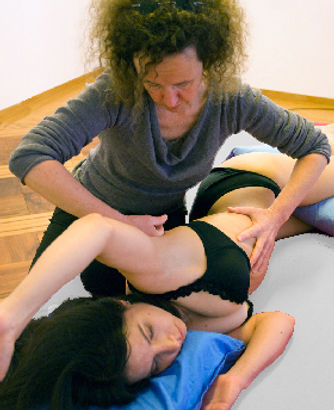

Ida Rolf
Ida Pauline Rolf (1896-1979) is the founder of the Rolfing® Structural Integration method that she developed and first taught in California, U.S.A. She is one of the first women to have obtained a PhD in biochemistry at the University of Columbia, New York, in 1920.
During her research into chronic diseases, she became interested in different body work such as yoga, osteopathy, and studied the effects of physical structure over physiological and motor functions. She developed the concept of Structural Integration based on the observation that posture and movement are dependant on the law of gravity, and can be supported by gravity rather than being weighed down by it. By modifying the network of connective tissue (or fascias) with a precise touch, posture can be reorganised and conditions of health improved.
Invited by Fritz Perls, the founder of Gestalt Therapy, Ida Rolf started to teach at the Esalen Institute in California in the sixties, and created her own institute in Boulder Colorado in the seventies. She taught until her death in 1979. Later on, the method of Structural Integration took the name of Rolfing® Structural Integration.
«The wonders are occurring only because of gravity and only because we know how to use gravity to create wonders. It is gravity that is the tool, it is gravity that is the therapist. All we are doing is directing the flow gravity by virtue of organizing the body as though it were an electric wire so that gravity can flow through it.»
Ida Rolf

What is fascia ?
Fascias can be compared to the skin of an orange, that separate each segment and pulp of the fruit and that can be fine or dense, depending on where they are located. In the body we call it the connective tissue. It surrounds and connects muscle groups, each muscle and each muscle fibre as well as the viscera, the nerves and the meninges.
Like a three-dimensional envelope, fascias bring support to our physical structure. It is like a true organ of posture that adapts to repetitive movements and tends to become distorted or shrink with time.
More or less innervated, fascias respond to touch with a speed that exceeds nerve impulses. As if we were touching a spider web, the information gets transmitted to the surrounding fascial net which reorganises itself after only a few manipulations.

What is Rolfing ?
Postural habits, repetitive movements, a sedentary life-style, life incidents (accidents, diseases, surgery…), emotional shocks and chronic stress create continual constraints in the body, that increase with time and with the compressing effect of the force of gravity. This leads to loss of mobility, pain, awkward or inappropriate postural habits and then, to loss of elasticity in the fascial network of the body.
Developed in the sixties in the United States by Dr. Ida P. Rolf, Rolfing® Structural Integration is a hands on educative approach to posture based on the effect of gravity and work on fascias. Thanks to the amazing capacity of our organism to adapt and to the plasticity of our tissues, Rolfing allows us to find adequate alignment and dynamism around our vertical axis. The outcome is a feeling of flexibility, of stability, and the decrease in or disappearance of pain.
Through its educative approach and touch, Rolfing invites us to explore the unique way in which we feel, hold ourselves and move. We will learn to refine our perceptions of our own body, of the surrounding space, of time and of our relationships to others with a progressive sense of ease and trust.
Today, Rolfing is one of the best known and widespread postural and structural methods in the United States, Brazil, Japan and Australia as well as in many European countries such as Germany, Italy, Switzerland, England, Spain, Holland…

What is Rolfing Mouvement ?
The educative approach, also called Rolfing Movement, allows a person to integrate gravitational force into his or her habitual perceptions concerning his/her posture and movement coordination. It opens possibilities for finding one’s full capacity of movement and expression.
Rolfing Movement is ideal for working in groups to explore postural dynamics, walking & breathing. For personal needs, it is also possible to have individual sessions or sessions on two to benefit from a trained-eye rolfer with personal verbal cues, and experiment a different touch that orients movement and facilitates coordination.
To notify that an individual Rolfing session includes a time for manipulation and a time for education and coordination in movement (Rolfing Movement).
Rolfing Movement mainly focuses on:
• perceptive aspects of our habitual movements
• finding our individual potential to move, moving in different ways while achieving the same goal
• discovering the meaning behind certain patterns of movement
• integrating gravity and creating ease and balance through self-education exercises
It is a good idea to experience Rolfing Movement in groups. It allows one to realise that there are as many movement strategies as there are human beings on this planet. There is no ideal movement, nor an ideal body, yet everyone can learn to integrate gravity and gain more muscular energy, flexibility and strength in his or her movement.
© 2018 by France Hatt-Arnold hattarnold@rolfing.ch Tél. +41 22 344 59 04

